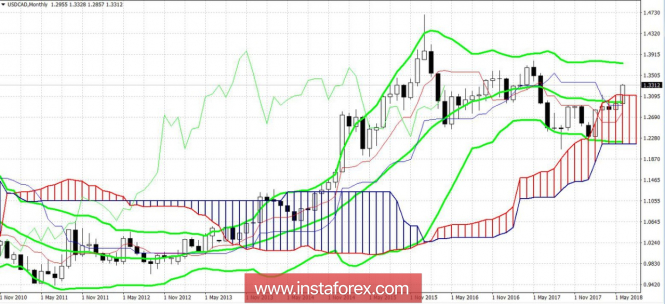
The pair USD / CAD is trading at annual highs, while the potential for price growth is not exhausted. The monthly chart of the pair says that the Canadian can fall in price to the 37th figure, namely to 1.3735 mark, where the top line Bollinger Bands is located.
The Canadian dollar is squeezed. On the one hand, the nervousness of the oil market awaits the outcome of the OPEC + summit, and on the other hand, Trump, who can not only leave the NAFTA, but also introduce new duties on imported cars, "breathes in the back". "We are considering options for introducing tariffs for cars that flood the US market," the US president wrote in his Twitter on the G7 summit. And if earlier it was only about cars from the EU (that is, the main blow was to Germany), now the option of imposing duties on all imported cars is being discussed.
Here, it is worth recalling that between Canada and the US in 1965, the Automobile Agreement was concluded, which then became part of the NAFTA, according to which the countries mutually canceled duties on cars, trucks, buses and spare parts. In turn, the Canadian auto industry consists mainly of assembly plants of foreign auto giants (Honda, Toyota General Motors, Ford, Chrysler and some others). Canada exports to the States more than 70% of the cars produced in the country for about $ 50 billion, so the threat of Trump to introduce protective import duties has affected the traders of the pair quite strongly. According to some economists, such actions can lead to serious consequences for the growth of the country's economy. The "wave effect", in their opinion, is fraught with even a recession.
It is also worth recalling that after the G7, relations between the leaders of Canada and the US have deteriorated significantly against the backdrop of mutual attacks and even accusations. Therefore, the probability of settling a trade conflict based on personal contacts is now minimal.
Also, the issue of the North American Free Trade Area Agreement (NAFTA) remains unresolved. In August, the year will begin as the parties try to restructure the deal, and at the moment, the situation did not manage to move from the dead end. Canadian Foreign Minister Chrystia Freeland said last week that the dialogue is still going on and the parties are ready to work on a new agreement "throughout the summer." Although earlier, the countries planned to complete the negotiation process in May, before the start of the pre-election race in Mexico, where on July 1, they will choose the president of the country.
This suggests that the dialogue has come to a deadlock, and hence the probability of the US exit from the NAFTA is still high. A few weeks ago, Donald Trump named his terms. He proposed to conclude not a trilateral agreement, but two separate agreements, the US with Canada and the US with Mexico. But Canadian Prime Minister Justin Trudeau categorically rejected this idea. After that, the relationship between him and Trump was aggravated at the G-7 summit, and the situation, in fact, hung in the air.
Such a fundamental background poses complex challenges for the Bank of Canada. Indicators of the economy as a whole are showing good results. Though, the GDP growth indicator slowed slightly (+ 0.3%). But at the same time, the basic indicators of inflation are close to the targeted two-percent level, unemployment remains at an acceptable level (5.8%), and the level of salaries demonstrates a positive trend. That is why the Canadian regulator took a "hawk" position in May, saying that further interest rate growth is justified. However, at the same meeting, the CBA of Canada noted another factor. The accompanying statement stated that "uncertainty in the field of trade policy negatively affects investment." In addition, Stephen Poloz repeatedly stressed the uncertainty surrounding the NAFTA in the context of further prospects for monetary policy.

Thus, a deep split in the trade relations between the US and Canada pushes the pair USD / CAD up, despite the "hawkish" intentions of the Bank of Canada and the growth of the main macroeconomic indicators. The probability of an increase in the rate in July fell significantly after the results of G7 and the vague prospects of NAFTA.
At the moment, the northern impulse of USD / CAD has faded somewhat, awaiting the outcome of another no less important for traders summit, OPEC +. Now, active negotiations are under way to increase oil production within the limits of the agreement on the limitation of production. According to the representatives of Saudi Arabia, this indicator should increase by 1 million barrels per day, while Russia proposes to increase production by 0.8-1.5 million b / d. Some countries were initially against this idea but negotiations are continuing, and there are already certain results. For example, Iran promised not to veto the relevant Cartel decision. Despite the fact that the intrigue is still preserved, and the results of the summit we learn on Saturday, the oil quotes are already under pressure. The barrel of Brent crude oil is traded within the 73rd figure, demonstrating bearish sentiment.

If the results of the OPEC + summit disappoint the oil traders, and "black gold" again loses its value, the northern trend of USD / CAD may get its continuation. The main target is 1.3735, although to achieve this level, the pair's bulls need to overcome the main resistance level of 1.3500. This will happen if the oil market remains under pressure, and Trump decides to exit the NAFTA and / or to introduce duties on imported cars. As a result, the Bank of Canada will take a wait-and-see stance about the rate hike, provoking the next price impulse of USD / CAD.